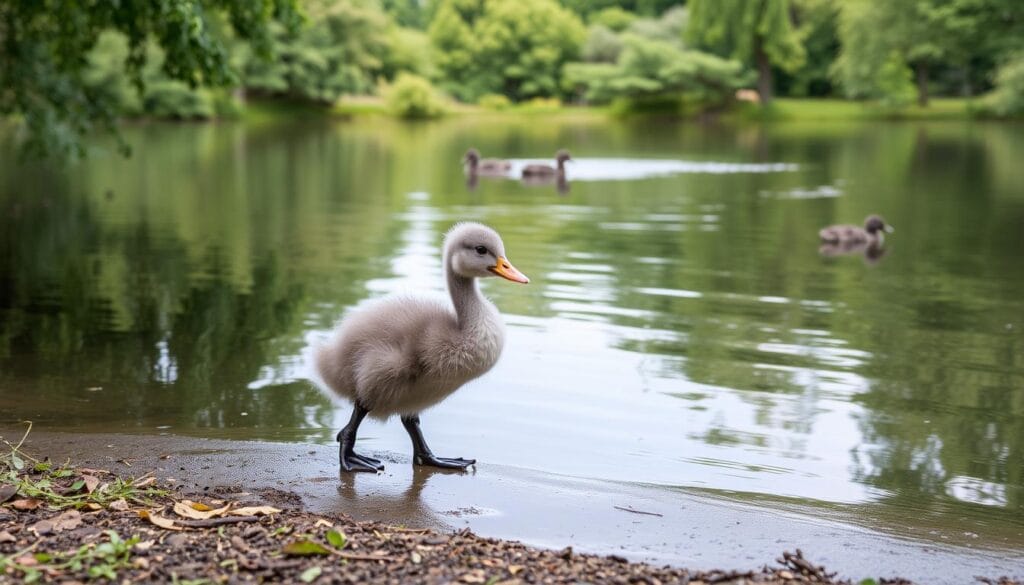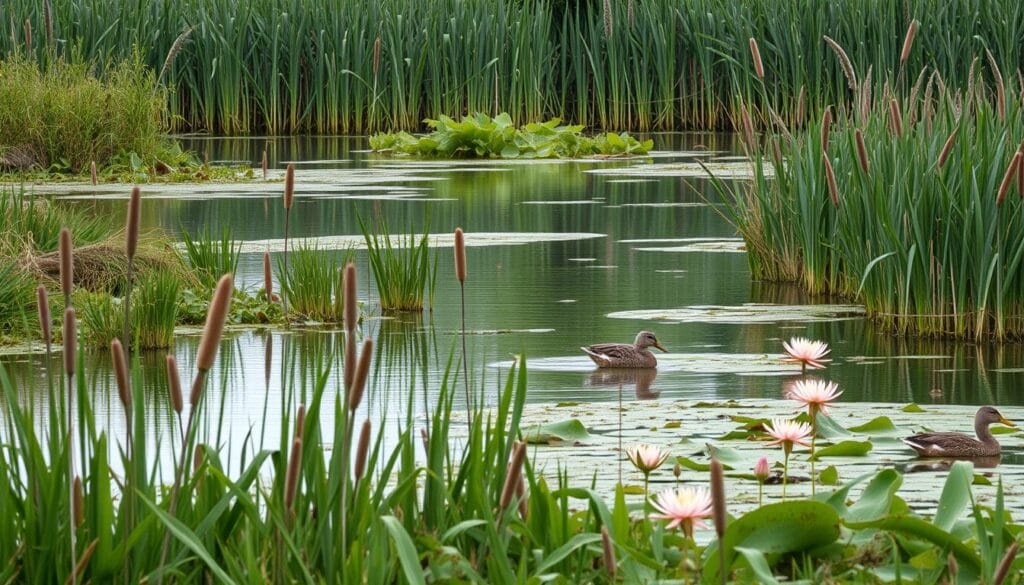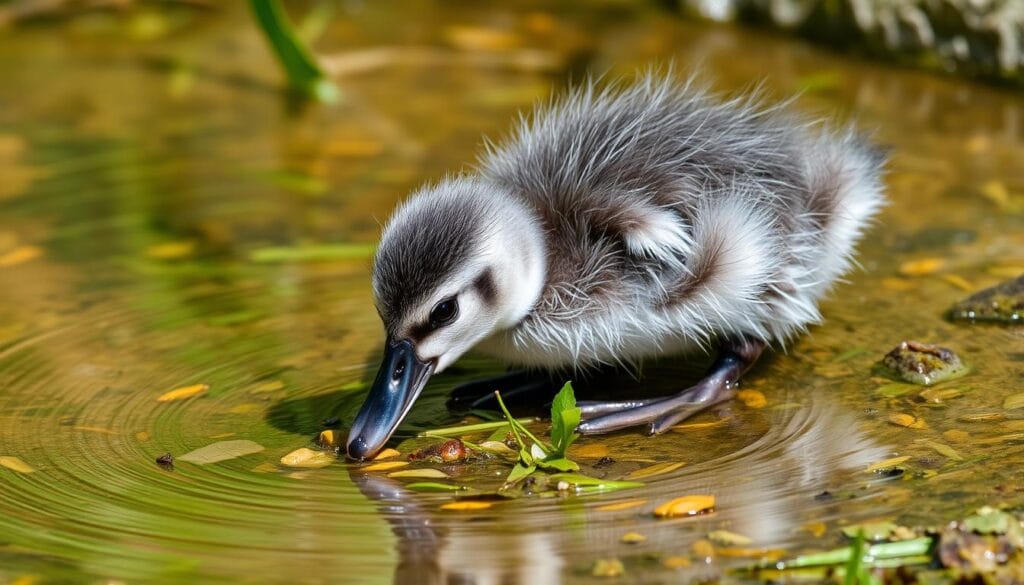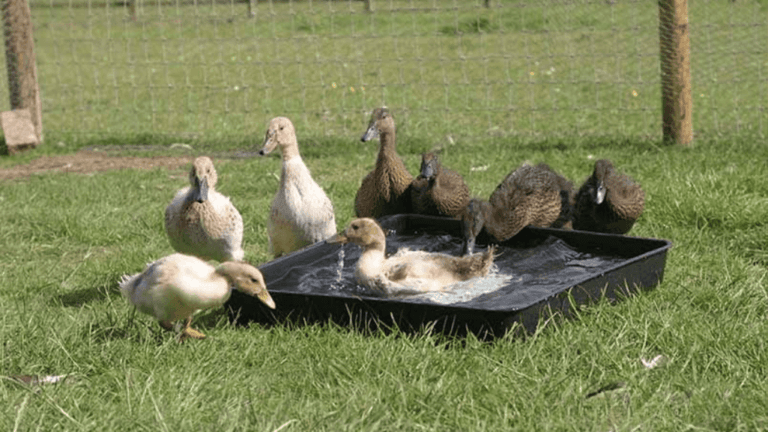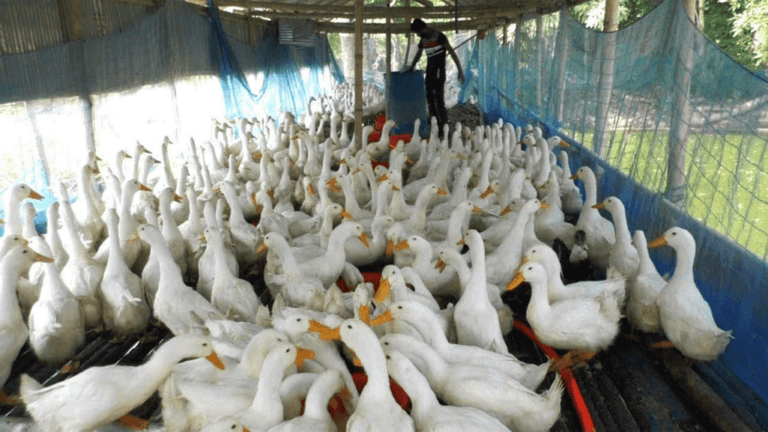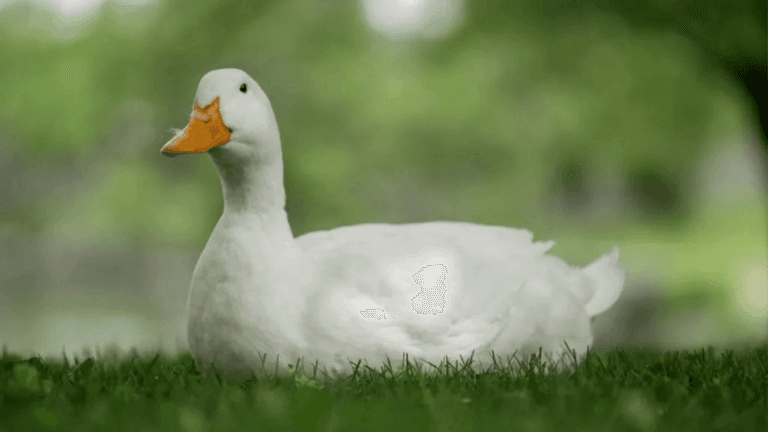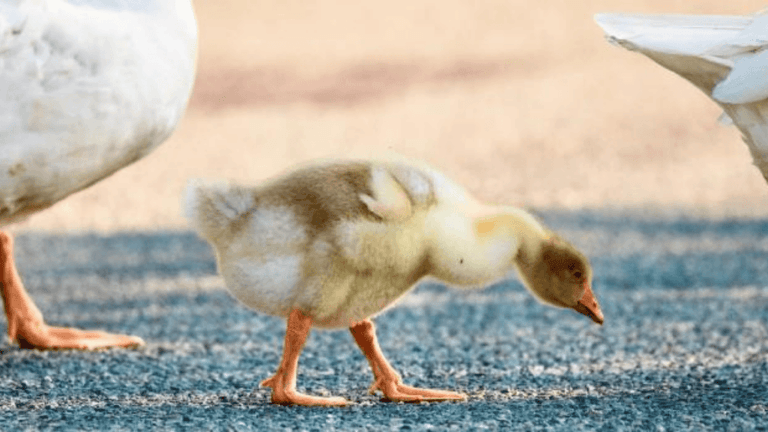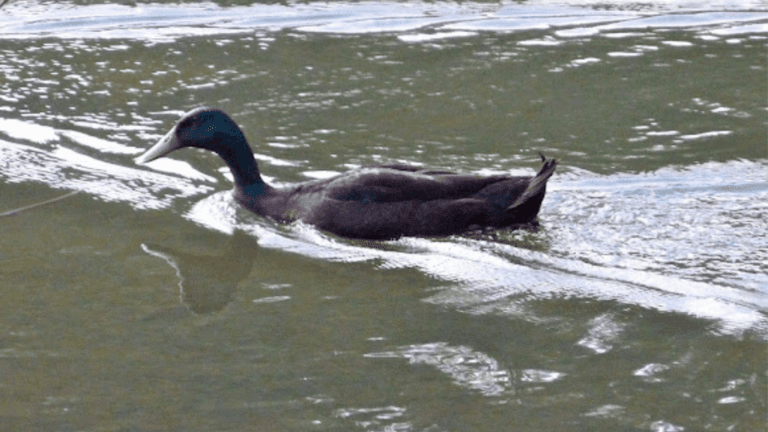Grey ducklings are rare and fascinating birds that capture the hearts of many. They are part of the Anas superciliosa family and call New Zealand home. Known as Pārera, these baby ducks have unique features that make them stand out.
Adult grey ducks are quite large, reaching lengths of 50-60 cm and weighing 900-1200 g. They have darkish brown bodies, grey bills, khaki legs, and dark brown eyes. Their face is warm buff with two clear black stripes, making them easily recognizable.
Grey ducklings are known for their beautiful iridescent green speculum on the upper wing. This area is bordered by a thin white line. As they grow, this feature becomes even more vibrant, adding to their allure. Their rarity makes them a sought-after sight for bird lovers and conservationists.
Key Takeaways
- Grey ducklings are rare waterfowl native to New Zealand
- Adult grey ducks measure 50-60 cm and weigh 900-1200 g
- They have distinctive black face stripes and an iridescent green speculum
- Grey ducklings are known as Pārera in New Zealand
- Their rarity makes them valuable to birdwatchers and conservationists
Introduction to the Grey Duckling
Grey ducklings, the fluffy chicks of the Pacific black duck, are rare in New Zealand’s waters. They catch the eye of bird lovers and those who care for nature. Their unique looks and low numbers make them special.
Defining characteristics of grey ducklings
Grey ducklings are known for their soft feathers and special look. They have olive-colored legs and feet, and a dark grey bill. As they grow, they get eye and bill stripes, making them look clean-faced.
Significance in waterfowl species
The grey duck, or pārera, is key to New Zealand’s ecosystem. It’s one of nine native ducks, adding to the area’s biodiversity. Its unique features, like the iridescent green speculum, make it stand out.
Brief overview of their rarity
Grey ducklings are in danger due to mixing with mallards. This mixing has greatly reduced their numbers, making them New Zealand’s most endangered duck. It’s hard to tell real grey ducklings from hybrids by looking at their legs and wings.
| Characteristic | Grey Duck | Mallard |
|---|---|---|
| Leg Color | Olive | Bright Orange |
| Bill Color | Dark Grey | Orange-and-Brown |
| Speculum Color | Iridescent Green | Blue with White Edges |
Grey Duckling Identification and Appearance
Identifying grey ducklings takes a sharp eye and knowledge of their special traits. These rare birds are often seen in wildlife sanctuaries. They have unique features that make them stand out from other waterfowl.
Physical Description of Adult Grey Ducks
Adult grey ducks have a striking look. They have feathers with pale buff edges, giving them a subtle elegance. Their face is warm buff, with two clear black stripes.
Their upper wings are rich brown, with an iridescent green speculum and a thin white band on the trailing edge.
Distinctive Features of Grey Ducklings
Grey ducklings look very different from adults. In bird nurseries, they catch the eye with their special colors and marks. They don’t look like the common mallard ducklings, which helps tell them apart.
Comparison with Similar Species
When you compare grey ducklings to others, you see clear differences. For example, mallard ducklings, or Rakiraki, have different colors. Here’s a table that shows the main differences:
| Feature | Grey Duckling | Mallard Duckling |
|---|---|---|
| Body Color | Pale grey | Yellow and brown |
| Face Markings | Subtle stripes | Bold eye stripe |
| Bill Color | Dark grey | Orange-yellow |
These differences help experts and bird lovers spot grey ducklings in places like wildlife sanctuaries and wetlands. Knowing these traits is key to keeping track of and protecting this rare bird.
Habitat and Distribution of Grey Ducklings
Grey ducklings are a rare waterfowl species found in various aquatic places across New Zealand. They live in shallow freshwater lakes, lagoons, and swamps. You can find them in Hawke’s Bay, Waikato, South Auckland, and Otago.
Their breeding habits change with their location. In Australia, they nest when it rains and food is plenty. In New Zealand, they breed seasonally, depending on the water levels. They build nests alone, often in tree hollows or on the ground.
Wildlife sanctuaries are key to protecting these rare birds. They work to keep their homes safe and create good places for them to breed. Grey ducklings usually lay 1 to 7 eggs, which take 25-31 days to hatch.
| Characteristic | Grey Duckling |
|---|---|
| Average Egg Size | 49.3 mm x 35.6 mm |
| Incubation Period | 25-31 days |
| Fledging Age | 35-40 days |
| Reproductive Maturity | 1 year |
Grey ducklings have to deal with many challenges in the wild. Predators like black-crowned night herons can be a threat to them. Conservation programs work hard to protect these birds and keep their numbers up.
Behavior and Life Cycle of Grey Ducklings
Grey ducklings, like their mallard ancestors, show interesting behaviors from birth to adulthood. They grow in bird nurseries, showing unique traits as they go.
Feeding Habits and Diet
Grey ducklings eat mostly aquatic plants, grains, and insects. They use their bills to pick up food from the water. As they get bigger, they eat a wider variety of plants.
Social Behavior and Interactions
Social interactions are key for duckling growth. In the bird nursery, they learn important skills from their mothers and siblings. They walk in a line, follow their mother, and play in the water.
Mating and Reproduction
Mating in grey ducks is similar to their wild mallard relatives. Males do courtship displays, like head-bobbing. Females show they’re ready by flat-backing. After mating, males often celebrate with a victory lap.
- Females typically lay 7-10 eggs per clutch
- Incubation lasts about 28 days
- Ducklings are precocial at birth
- Young ducks start flying at around two months old
Knowing these behaviors helps in caring for grey ducklings. It ensures their well-being from the bird nursery to adulthood.
Conservation Status and Challenges
Grey ducklings are rare and face big challenges due to their limited numbers and where they live. Like many native waterfowl in New Zealand, they struggle with losing their homes, competition from invaders, and the danger of mixing with other species. Protecting these birds is crucial, which is why wildlife sanctuaries are key.
Predators are a big threat to grey ducklings and other waterfowl. In North America, badgers, mink, and corvids hurt duckling survival rates a lot. Up to 60% of badgers have eaten duck eggs recently. Coastal areas also have big problems, with gulls being a major threat. The black-backed gull is thought to be a big reason why common eider populations are falling in the Atlantic Flyway.
Efforts to save grey ducklings and others like them focus on protecting their homes, keeping an eye on their numbers, and studying their genes. Researchers aim to check how pure the grey duck populations are and deal with hybridization issues. Sanctuaries give these rare birds a safe place away from predators and people. Keeping up with research and conservation work is key to saving this special waterfowl and its home.



